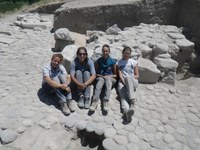Update from the Field: Professor Lorenzo d'Alfonso at Kınık Höyük

During a very successful 2017 excavation season at Kınık Höyük-Niğde in Turkey, several operations were opened or continued across the mound by an Italian-American team of archaeologists, primarily from ISAW and the University of Pavia, under the direction of Professor Lorenzo d’Alfonso. These operations included excavations into several areas atop the mound and into the surrounding ramparts, with different areas dating from the Late Antique period to the Early Iron Age.
Within the acropolis, on the north side of the mound, a Hellenistic occupation area, characterized by a previously undiscovered cobblestone-paved surface and cut-stone structure, was excavated by Nathan Lovejoy. Nathan also excavated a Late Iron Age room associated with an incredible number of painted vessels and artefacts for textile production in the same area, slightly lower down the mound.

To the west of this area, also within the northern acropolis, Andrea Trameri, assisted by Kate Justement, continued excavations of a multi-period sanctuary in an attempt to understand the various occupation phases and the apparent diachronic continuity of the space.
On the south side of the mound, Lorenzo Castellano and Emre Dalkıç (Bilken Uni, Ankara), exposed a section of the Early-Middle Iron Age rampart and wall of the settlement, as well as a Late Iron Age grain silo – a rare feature of contemporaneous sites in the region. Alessio Mantovan (Uni Milan) excavated the Iron Age northern rampart to expose the fortifications of the Bronze Age, which we now know included the use of wooden beams.
And lastly, continued excavations of Achaemenid and Hellenistic occupation areas atop the mound were conducted by Alvise Matessi and Roberta Casagrande-Kim, respectively. Marble statues of raports and many other artefacts were analyzed with the ISAW PXRF in the lab by Dr. Basso (MET Museum), restored by N. Can Cihan and a team of students of the School of Restoration of Nevşehir (TR), and studied by all members of the team. Excursions to underground cities to the Hittite capital Hattusa, and to the local Acquapark on weekends, as well as some delicious BBQ added fun to the campaign. In all, it was a very fruitful season!